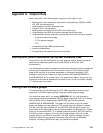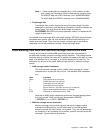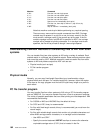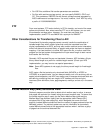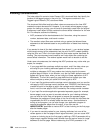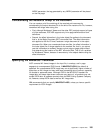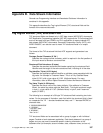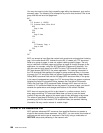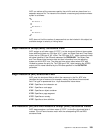
For VSE files, additional file transfer parameters are available.
For files with machine carriage control, you can specify BINARY, CRLF and
CC. This provides an EBCDIC file with correct carriage controls separated by
ASCII newlines and carriage returns. You must, however, “trick” ACIF by using
a prefix of X'0320202020200A'.
FTP
From most systems, FTP works similarly to PC file transfer, and most of the same
options are provided. Also, when executing FTP on an AIX system, you can omit
the extraneous carriage return. However, you must test and check your
implementation; some FTPs use IMAGE as a synonym for BINARY.
Other Considerations for Transferring Files to AIX
Conventional file transfer programs cannot correctly handle the combination of
variable-length files, which contain bytes that cannot be translated from their
original representation to ASCII, and may also contain machine control characters,
mixed line data and structured fields, or special code points that have no standard
mapping
4
. Your best solution is to either NFS-mount the file, or write a small filter
program on the host system that appends the 2-byte record length to each record
and transfer the file binary.
Generally, NFS-mounted files are not translated. However, NFS includes a 2-byte
binary record length as a prefix for variable-length records. (Check your NFS
implementation; you may have to use special parameters.)
Note: Some NFS systems do not supply the binary record length for fixed-length
files.
ACIF treats a file that contains only structured fields (MO:DCA or AFPDS or
LIST3820) as a special case. You can always transfer such a file as binary with no
special record separator, and ACIF can always read it because structured fields are
self-defining, containing their own length; ACIF handles print files and print
resources (form definitions, fonts, page segments, overlays, and so on) in the same
way.
Invoke Medium Map (IMM) Structured Field
Retrieval programs must be able to detect which medium map is active, to ensure
that pages are reprinted (or viewed) using the correct medium map. To ensure that
the correct medium map is used, use the Active Medium Map triplet and the
Medium Map Page Number triplet (from the appropriate Index Element [IEL]
structured field in the index object file), which designate the name of the last
explicitly invoked IMM structured field and the number of pages produced since the
IMM was invoked. The retrieval system can use this information to dynamically
create IMM structured fields at the appropriate locations when it retrieves a group
of pages from the archived document file.
4
When ASCII is specified, for example, the file transfer program may destroy the data in translation. When binary is specified, the
file transfer program may not be able to indicate record lengths.
Appendix A. Helpful Hints
183







